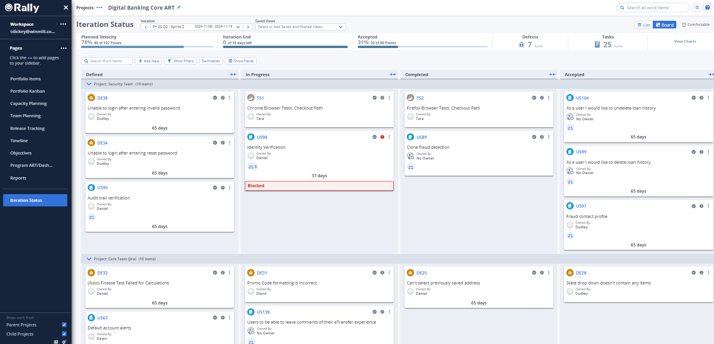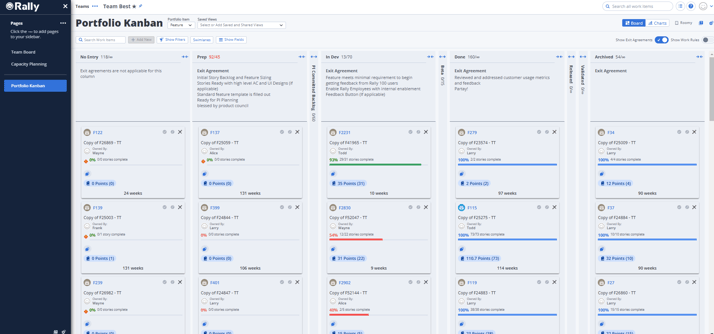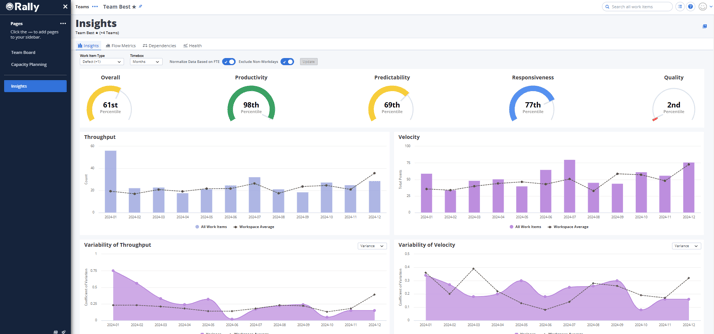Many organizations rely on Jira for agile team execution but struggle to gain visibility and control across multiple teams. This blog post, written by our Senior Solutions Engineer, Tyler Dickey, explores how combining Jira with Rally can address these challenges. Discover how this powerful duo can enhance your agile practices and unlock greater efficiency.
The Jira Conundrum
I cannot count the number of times I have heard the following when showing Rally: “If my team is already using Jira, why would we need Rally? Don’t they do the same thing?” It may be surprising, but I love this question, and the answer is yes and no.
Yes, they are both leaders in agile execution at the team level. Jira allows individual teams to manage their user stories, defects, tasks, and features in a consolidated and collaborative way. Do not get me wrong; for many companies, this may be all they need.
Scaling Beyond the Team Level
But what about when we need to see information about multiple teams, a team of teams, program, product, or portfolio? Well, that is where the no comes in. While Jira does an excellent job at an individual team level, Rally scales easily to the team of teams, programs, and higher levels. Rally also boasts best-in-class capacity planning for teams, prioritization of work, road mapping, and insights reporting that you must see and believe.
However, this article is not simply about comparing Rally and Jira. It’s meant to show you how you can leverage using the two tools together as part of your enterprise solution. We’ll show the benefits of adding Rally to Jira to understand the link between work across teams, products, and programs, gain insight into team capacity planning, and demonstrate best-in-class reporting.
Best of all, there is ZERO impact on your engineering team’s day-to-day work! We will also introduce an easy, no-code way to integrate the two using ConnectAll and discuss why using Rally instead of Jira Align is advantageous.
Scaling with Ease
When using Jira on its own, it is difficult to see into the work of multiple teams without performing some serious navigational gymnastics. We know how important it is to understand not only what different teams are working on but also the dependencies that teams have with each other and the progress of those dependencies as they relate to our own work. Rally has multiple avenues for displaying this information in a way that can be easily consumed by program managers, product owners, or the entire organization.
As a Program Manager or RTE (Release Train Engineer), it is critical to monitor the progress of all the work being done across teams. Below is an example of a team-of-teams board that illustrates this.

A user can see each work item (User Story, Test Case, Defect) being worked on across all teams and the progress each has made. They can also see who owns it, whether it is blocked, and whether there are dependencies. Furthermore, without leaving this view, they can open any work item as a flyout with more information.
Notice that the data for the Core Team shown here comes from Jira, while the Security Team works out of Rally. The team's execution of the work does not affect the Program Manager's ability to use Rally.
Imagine seeing all the relevant work that several Jira teams are tackling on a single screen!
Program Managers can also use portfolio-level Kanbans to examine the broader flow of work and gain insight into Features and Epics across the organization.

Using simple parent-child relationships that already exist in Jira, Rally can help users understand the bigger picture and the progress of work moving across the organization.
Capacity Planning (The Great Unknown, or is it?)
The most frequent challenge we encounter when working with Jira teams, or any agile teams for that matter, is nailing down capacity planning (i.e., how much work each team can accomplish in a given time period).
Rally calculates capacity at the team level based upon the past year of performance using variables of:
- Time Period – What duration are we forecasting (Sprint, Release, etc.)?
- Team Availability in Time Period – A % of the team's availability, taking into account holidays, PTO, etc...
- Complexity – Does the work have many unknowns? Is it new, or is it well understood?
.png?width=714&height=328&name=Capacity%20Forecast%20(Team%20Board).png)
This will calculate the confidence of how much work a team can produce by both work items and points. Rally allows customers to plug that capacity in and plan work for the team until they hit that threshold.
Insights Reporting and Flow Metrics
How often do you pull really great reports directly from Jira? If you are like most customers, the answer is probably never. Advanced analytic capability is not something that you will find out of the box in Jira. On the other hand, insights and analytics are Rally's DNA!
Even if your organization is not ready to scale to programs or higher, Rally can benefit individual agile teams operating out of Jira by providing excellent Flow Metrics, Cycle Time, Cumulative Flow Diagrams, and more. For the full suite of Flow Metrics click here.
Additionally, Rally provides Rally Insights, which highlights your team’s performance in comparison to other organizations based on the Software Development Performance Index (SDPI). For further details, please refer to the brief tech doc.

Connecting Rally and Jira
At this point, you might be wondering how exactly we integrate Rally and Jira. Your mind might jump to a traditional integration using third-party software, which is complex and requires frequent maintenance whenever a configuration change is needed.
Broadcom ValueOps offers a solution called ConnectAll. This integration hub makes it quick and easy to build and maintain integrations without coding knowledge. Jira and Rally each have out-of-the-box connectors in ConnectAll that make creating a link between the 2 products extremely simple—it takes 10-15 minutes. If you do not believe me, see our how-to doc.
Rally vs. Jira Align
Jira Align is an Atlassian product that can be integrated with Jira in a similar way to how Rally provides program-level aggregation of Jira data. Many customers hear the name and assume it is the most natural fit for integration into Jira. However, Jira Align, as it is known today, was previously a product called AgileCraft, which Atlassian acquired in 2019. Jira and Jira Align were not originally developed together, but they function like most products that require integration.
The real question is how Jira Align compares to Rally. If you’re looking for basic reports and the aggregation of Jira data at the program level, Jira Align can help you achieve that. However, if you want to move beyond the program level, accurately forecast your team’s capacity, or simply desire outstanding analytics, then Rally is the better option.
Founded in 2013, AgileCraft has long been integrated with Jira, well before the creation of JiraAlign or its previous name.
If you are ready to scale your agile practice or access analytics that will revolutionize your efficiency, contact Winmill. You can schedule a personalized demonstration with me, and we will tailor a solution that is second to none.

